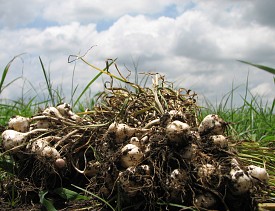Winter Gardening: The Art of Growing Garlic
 Now is the time to plant garlic if you haven't done so already. Like other bulbs (think tulips), garlic enjoys overwintering in cold conditions (a process known as stratification). If you've never grown your own, all you need to know is that one clove will grow one head of garlic.
Now is the time to plant garlic if you haven't done so already. Like other bulbs (think tulips), garlic enjoys overwintering in cold conditions (a process known as stratification). If you've never grown your own, all you need to know is that one clove will grow one head of garlic.
Choosing Garlic For Planting
You can plant any variety of garlic which you enjoy, although make sure it is fresh and viable, not cooked, preserved or moldy. However, the same advantage exists when choosing garlic to grow as with other vegetables in your garden: almost endless variety. So why not try something new?
Flipping through a heirloom seed catalogue, you can find varieties of garlic not available in grocery stores or most farmers markets. For instance, the Seed Savers Exchange catalogue boasts twelve varieties of garlic including the red-striped Chesnok Red and the hot Georgian Fire, which they suggest goes well with salsa.
How to Plant
Plant garlic in a sunny location with fertile soil. Divide each head of garlic into individual cloves and plant 1-2 inches deep, with the rough flat end facing down and the pointy end facing up. Landscaping expert Douglas Hunt recommends that garlic cloves should be planted with two inches of soil on top of them. Plant about 4-6 inches apart in rows one foot apart, or interplant with your other plants.
If you have harsh winters, it is a good idea to cover planted garlic beds with a mulch such as straw. This will protect garlic from the most extreme low temperatures and allow shoots to grow up in the spring while impeding competing weeds.
Spring, Summer and Harvest
In spring, your garlic will awaken, shoot up a stalk and continue the task of growing a new head of garlic. At a certain point in summer garlic sends forth a flower stalk known as a “garlic scape.” These scapes are commonly cut off near their base before flowering in order to redirect the energy the plant would invest into the flower, back into the bulb (no flower = bigger bulb). The scape can be used in place of garlic in many recipes — as a spice in pickling, in stir fries, in soups, etc. Some farmers even bring their scapes to market as a specialty item when they are “in season.”
The garlic is ready to harvest when the leaf stalk partially dries out and begins to bend over. If your soil is loose, you can literally just pull garlic up, holding firmly at the base. If your soil is more firm and you find that directly pulling is tearing the skin off your garlic, you can use a trowel or garden fork to loosen the soil.
You can either use garlic fresh or cure it for longer storage. To cure, leave garlic to hang in a cool, dry place out of direct sunlight for about a week.
Tips: According to the classic gardening manual Vegetable Gardening, “Many gardeners use garlic tea as a spray to control aphids, white flies, and other vegetable pests. Garlic also helps control rodents in fruit orchards.” The recipe they provide for garlic tea is two grated cloves per gallon of warm water, or one teaspoon of garlic powder per gallon of water.
Sources for this article:
- Ashworth, Suzanne. Seed to Seed. Seed Savers Exchange, Iowa 2002.
- Bonnie, Fred. Vegetable Gardening. Oxmoor House, Alabama 1976.
Jordan Laio is a Networx writer.
Updated June 26, 2018.
Looking for a Pro? Call us (866) 441-6648

Landscaping Average Costs
Landscapers Experiences

Yard Clean Up Left Our Lawn Looking Fantastic

New Low-Maintenance Landscaping To Update Our Yard



